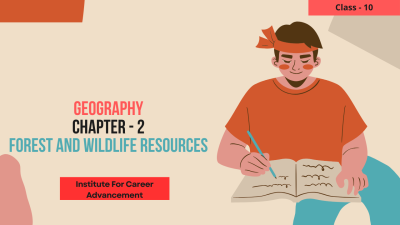Courses


 Compare
Compare
Lifeline of Natural Economy is a term used to describe the vital resources and systems that underpin the economic activities of a region or nation. These resources are often derived from the natural environment and are essential for supporting various industries and livelihoods. Key components of a natural economy's lifeline: Natural Resources: These include minerals, forests, water, land, and wildlife. They are used for extraction, agriculture, energy production, and other economic activities. Infrastructure: This refers to the physical structures and facilities that support economic activities, such as roads, bridges, ports, and transportation networks. Technology: Technological advancements can enhance the efficiency of natural resource extraction and utilization, but they can also have environmental impacts. Human Capital: The skills, knowledge, and labor of people are essential for managing natural resources and driving economic growth. Challenges and Considerations: Sustainability: The overexploitation of natural resources can lead to environmental degradation and depletion. Sustainable practices are essential for ensuring the long-term viability of a natural economy. Economic Diversification: Relying too heavily on natural resources can make an economy vulnerable to fluctuations in global markets and environmental factors. Diversifying economic activities can help mitigate these risks. Climate Change: Climate change poses significant threats to natural resources and can disrupt economic activities. Adapting to climate change is crucial for the survival of natural economies. In conclusion, the lifeline of a natural economy is a delicate balance between utilizing natural resources for economic development and preserving the environment for future generations. Sustainable practices and careful management are essential for ensuring the long-term prosperity of such economies. প্রাকৃতিক অর্থনীতির জীবনরেখা এমন একটি শব্দ যা একটি অঞ্চল বা জাতির অর্থনৈতিক ক্রিয়াকলাপকে ভিত্তি করে গুরুত্বপূর্ণ সম্পদ এবং ব্যবস্থা বর্ণনা করতে ব্যবহৃত হয়। এই সম্পদগুলি প্রায়শই প্রাকৃতিক পরিবেশ থেকে উদ্ভূত হয় এবং বিভিন্ন শিল্প ও জীবিকা নির্বাহের জন্য প্রয়োজনীয়। প্রাকৃতিক অর্থনীতির জীবনরেখার মূল উপাদানগুলিঃ প্রাকৃতিক সম্পদঃ এর মধ্যে রয়েছে খনিজ, বন, জল, জমি এবং বন্যপ্রাণী। এগুলি উত্তোলন, কৃষি, শক্তি উৎপাদন এবং অন্যান্য অর্থনৈতিক ক্রিয়াকলাপের জন্য ব্যবহৃত হয়। পরিকাঠামোঃ এটি সড়ক, সেতু, বন্দর এবং পরিবহন নেটওয়ার্কের মতো অর্থনৈতিক ক্রিয়াকলাপকে সমর্থন করে এমন ভৌত কাঠামো এবং সুবিধাগুলিকে বোঝায়। প্রযুক্তিঃ প্রযুক্তিগত অগ্রগতি প্রাকৃতিক সম্পদ উত্তোলন এবং ব্যবহারের দক্ষতা বাড়িয়ে তুলতে পারে, তবে এগুলির পরিবেশগত প্রভাবও থাকতে পারে। মানব মূলধনঃ প্রাকৃতিক সম্পদ পরিচালনা এবং অর্থনৈতিক প্রবৃদ্ধির জন্য মানুষের দক্ষতা, জ্ঞান এবং শ্রম অপরিহার্য। চ্যালেঞ্জ ও বিবেচনার বিষয়ঃ স্থায়িত্বঃ প্রাকৃতিক সম্পদের অতিরিক্ত শোষণ পরিবেশের অবক্ষয় এবং হ্রাস ঘটাতে পারে। প্রাকৃতিক অর্থনীতির দীর্ঘমেয়াদী কার্যকারিতা নিশ্চিত করার জন্য টেকসই অনুশীলন অপরিহার্য। অর্থনৈতিক বৈচিত্র্যঃ প্রাকৃতিক সম্পদের উপর অত্যধিক নির্ভরশীলতা একটি অর্থনীতিকে বিশ্ব বাজারের ওঠানামা এবং পরিবেশগত কারণগুলির জন্য ঝুঁকিপূর্ণ করে তুলতে পারে। অর্থনৈতিক কার্যক্রমের বৈচিত্র্য এই ঝুঁকিগুলি হ্রাস করতে সহায়তা করতে পারে। জলবায়ু পরিবর্তনঃ জলবায়ু পরিবর্তন প্রাকৃতিক সম্পদের জন্য উল্লেখযোগ্য হুমকি সৃষ্টি করে এবং অর্থনৈতিক কার্যক্রম ব্যাহত করতে পারে। প্রাকৃতিক অর্থনীতির টিকে থাকার জন্য জলবায়ু পরিবর্তনের সঙ্গে মানিয়ে নেওয়া অত্যন্ত গুরুত্বপূর্ণ। পরিশেষে, প্রাকৃতিক অর্থনীতির জীবনরেখা হল অর্থনৈতিক উন্নয়নের জন্য প্রাকৃতিক সম্পদ ব্যবহার এবং ভবিষ্যৎ প্রজন্মের জন্য পরিবেশ সংরক্ষণের মধ্যে একটি সূক্ষ্ম ভারসাম্য। এই ধরনের অর্থনীতির দীর্ঘমেয়াদী সমৃদ্ধি নিশ্চিত করার জন্য টেকসই অনুশীলন এবং যত্নশীল ব্যবস্থাপনা অপরিহার্য।
₹599
0 Lessons
Hours

 Compare
Compare
Manufacturing Industries is a crucial chapter in Class 10 Geography that explores the significance of manufacturing as an economic activity. It delves into the different types of manufacturing industries, their distribution, and the challenges faced by the manufacturing sector. Key topics covered in this chapter include: Types of Manufacturing: Cotton textile, iron and steel, information technology, and biotechnology. Distribution of Industries: Regional and global patterns. Factors Influencing Industrial Location: Raw materials, labor, capital, and infrastructure. Challenges Facing Manufacturing: Competition, globalization, and environmental concerns. Industrial Development: Government policies and initiatives. By studying this chapter, students gain a deeper understanding of the importance of manufacturing in economic development, the challenges faced by the manufacturing sector, and the need for sustainable industrial practices. উৎপাদন শিল্প দশম শ্রেণির ভূগোলের একটি গুরুত্বপূর্ণ অধ্যায় যা অর্থনৈতিক কার্যকলাপ হিসাবে উৎপাদনের তাৎপর্য অন্বেষণ করে। এটি বিভিন্ন ধরনের উৎপাদন শিল্প, তাদের বিতরণ এবং উৎপাদন ক্ষেত্রের সম্মুখীন হওয়া চ্যালেঞ্জগুলি নিয়ে আলোচনা করে। এই অধ্যায়ে অন্তর্ভুক্ত মূল বিষয়গুলি হলঃ উৎপাদনের প্রকারঃ সুতির বস্ত্র, লোহা ও ইস্পাত, তথ্য প্রযুক্তি এবং জৈবপ্রযুক্তি। শিল্পের বিতরণঃ আঞ্চলিক ও বৈশ্বিক নিদর্শন। শিল্পের অবস্থানকে প্রভাবিত করার কারণগুলিঃ কাঁচামাল, শ্রম, মূলধন এবং পরিকাঠামো। উৎপাদনের চ্যালেঞ্জঃ প্রতিযোগিতা, বিশ্বায়ন এবং পরিবেশগত উদ্বেগ। শিল্প উন্নয়নঃ সরকারি নীতি ও উদ্যোগ। এই অধ্যায়টি অধ্যয়নের মাধ্যমে, শিক্ষার্থীরা অর্থনৈতিক উন্নয়নে উৎপাদনের গুরুত্ব, উৎপাদন ক্ষেত্রের সম্মুখীন হওয়া চ্যালেঞ্জ এবং টেকসই শিল্প অনুশীলনের প্রয়োজনীয়তা সম্পর্কে গভীর ধারণা অর্জন করে।
₹599
0 Lessons
Hours

 Compare
Compare
Minerals and Energy Resources is a crucial chapter in Class 10 Geography that explores the significance of minerals and energy in our modern world. It delves into the types of minerals, their distribution, and the importance of energy resources. Key topics covered in this chapter include: Types of Minerals: Metallic and non-metallic minerals. Distribution of Minerals: Global patterns and factors affecting mineral distribution. Importance of Minerals: Industrial, technological, and economic benefits. Energy Resources: Conventional and non-conventional sources. Energy Crisis: Challenges and strategies for energy conservation. By studying this chapter, students gain a deeper understanding of the importance of minerals and energy in our daily lives, the challenges associated with their extraction and use, and the need for sustainable resource management. খনিজ ও শক্তি সম্পদ দশম শ্রেণির ভূগোলের একটি গুরুত্বপূর্ণ অধ্যায় যা আমাদের আধুনিক বিশ্বে খনিজ ও শক্তির গুরুত্ব অন্বেষণ করে। এটি খনিজগুলির প্রকার, তাদের বন্টন এবং শক্তি সম্পদের গুরুত্ব নিয়ে আলোচনা করে। এই অধ্যায়ে অন্তর্ভুক্ত মূল বিষয়গুলি হলঃ খনিজগুলির প্রকারঃ ধাতব এবং অ-ধাতব খনিজ। খনিজ বিতরণঃ খনিজ বিতরণকে প্রভাবিত করে এমন বৈশ্বিক নিদর্শন এবং কারণ। খনিজগুলির গুরুত্বঃ শিল্প, প্রযুক্তিগত এবং অর্থনৈতিক সুবিধা। শক্তি সম্পদঃ প্রচলিত ও অপ্রচলিত উৎস। শক্তি সংকটঃ শক্তি সংরক্ষণের জন্য চ্যালেঞ্জ এবং কৌশল। এই অধ্যায়টি অধ্যয়নের মাধ্যমে, শিক্ষার্থীরা আমাদের দৈনন্দিন জীবনে খনিজ ও শক্তির গুরুত্ব, তাদের উত্তোলন ও ব্যবহারের সাথে সম্পর্কিত চ্যালেঞ্জ এবং টেকসই সম্পদ ব্যবস্থাপনার প্রয়োজনীয়তা সম্পর্কে গভীর ধারণা অর্জন করে।
₹599
0 Lessons
Hours

 Compare
Compare
Agriculture is a crucial chapter in Class 10 Geography that explores the significance of agriculture as a primary economic activity. It delves into the different types of farming systems, agricultural inputs, and the challenges faced by agriculture. Key topics covered in this chapter include: Types of Farming: Subsistence and commercial farming. Agricultural Inputs: Land, labor, capital, and technology. Agricultural Practices: Traditional and modern methods. Agricultural Challenges: Soil erosion, water scarcity, pests, and diseases. Agricultural Reforms: Government policies and initiatives. By studying this chapter, students gain a deeper understanding of the importance of agriculture in providing food, supporting livelihoods, and contributing to economic development. দশম শ্রেণির ভূগোলের একটি গুরুত্বপূর্ণ অধ্যায় হল কৃষি যা প্রাথমিক অর্থনৈতিক কার্যকলাপ হিসাবে কৃষির গুরুত্ব অন্বেষণ করে। এটি বিভিন্ন ধরনের কৃষি ব্যবস্থা, কৃষি উপকরণ এবং কৃষির সম্মুখীন হওয়া চ্যালেঞ্জগুলি নিয়ে আলোচনা করে। এই অধ্যায়ে অন্তর্ভুক্ত মূল বিষয়গুলি হলঃ কৃষিকাজের প্রকারঃ জীবিকা নির্বাহ ও বাণিজ্যিক চাষ। কৃষি উপকরণঃ জমি, শ্রম, মূলধন এবং প্রযুক্তি। কৃষি পদ্ধতিঃ ঐতিহ্যবাহী এবং আধুনিক পদ্ধতি। কৃষি সংক্রান্ত সমস্যাঃ মৃত্তিকা ক্ষয়, জলের অভাব, কীটপতঙ্গ এবং রোগব্যাধি। কৃষি সংস্কারঃ সরকারি নীতি ও উদ্যোগ। এই অধ্যায়টি অধ্যয়নের মাধ্যমে শিক্ষার্থীরা খাদ্য সরবরাহ, জীবিকা নির্বাহ এবং অর্থনৈতিক উন্নয়নে অবদান রাখার ক্ষেত্রে কৃষির গুরুত্ব সম্পর্কে গভীর ধারণা অর্জন করে।
₹599
0 Lessons
Hours

 Compare
Compare
Water Resources is a crucial chapter in Class 10 Geography that explores the significance of water as a vital natural resource. It delves into the distribution of water on Earth, its uses, and the challenges associated with water scarcity and pollution. Key topics covered in this chapter include: Distribution of Water: Oceans, freshwater, and groundwater. Uses of Water: Agriculture, industry, domestic use, and hydropower. Water Scarcity: Causes, consequences, and strategies for water conservation. Water Pollution: Types, sources, and impacts on ecosystems and human health. Water Management: Sustainable practices and international cooperation. By studying this chapter, students gain a deeper understanding of the importance of water as a resource, the challenges faced in managing water resources, and the need for sustainable water practices. দশম শ্রেণির ভূগোলের একটি গুরুত্বপূর্ণ অধ্যায় হল জল সম্পদ যা একটি গুরুত্বপূর্ণ প্রাকৃতিক সম্পদ হিসাবে জলের গুরুত্ব অন্বেষণ করে। এটি পৃথিবীতে জলের বন্টন, এর ব্যবহার এবং জলের ঘাটতি ও দূষণের সাথে সম্পর্কিত চ্যালেঞ্জগুলি নিয়ে আলোচনা করে। এই অধ্যায়ে অন্তর্ভুক্ত মূল বিষয়গুলি হলঃ জলের বন্টন-মহাসাগর, মিঠা জল এবং ভূগর্ভস্থ জল। জলের ব্যবহারঃ কৃষি, শিল্প, গার্হস্থ্য ব্যবহার এবং জলবিদ্যুৎ। জলের অভাবঃ জল সংরক্ষণের কারণ, পরিণতি এবং কৌশল। জল দূষণঃ বাস্তুতন্ত্র এবং মানুষের স্বাস্থ্যের উপর প্রকার, উৎস এবং প্রভাব। জল ব্যবস্থাপনাঃ টেকসই অনুশীলন এবং আন্তর্জাতিক সহযোগিতা। এই অধ্যায়টি অধ্যয়নের মাধ্যমে, শিক্ষার্থীরা সম্পদ হিসাবে জলের গুরুত্ব, জল সম্পদ পরিচালনার ক্ষেত্রে যে চ্যালেঞ্জগুলির মুখোমুখি হয় এবং টেকসই জল অনুশীলনের প্রয়োজনীয়তা সম্পর্কে গভীর ধারণা অর্জন করে।
₹599
0 Lessons
Hours

 Compare
Compare
Forest and Wildlife Resources is a crucial chapter in Class 10 Geography that explores the significance of forests and wildlife in our ecosystem. It delves into the types of forests, their distribution, and the importance of conserving both forests and wildlife. Key topics covered in this chapter include: Types of Forests: Tropical, temperate, and coniferous forests. Distribution of Forests: Global patterns and factors affecting forest distribution. Importance of Forests: Ecological, economic, and social benefits. Forest Depletion: Causes, consequences, and efforts to conserve forests. Wildlife Resources: Types, distribution, and importance. Wildlife Conservation: Challenges and strategies for protecting wildlife. National Parks and Wildlife Sanctuaries: Their role in conserving biodiversity. By studying this chapter, students gain a deeper understanding of the interconnectedness of forests and wildlife, the threats they face, and the importance of preserving these valuable resources for future generations. বন ও বন্যপ্রাণী সম্পদ দশম শ্রেণির ভূগোলের একটি গুরুত্বপূর্ণ অধ্যায় যা আমাদের বাস্তুতন্ত্রে বন ও বন্যপ্রাণীর গুরুত্ব অন্বেষণ করে। এটি বনের ধরন, তাদের বন্টন এবং বন ও বন্যপ্রাণী উভয়ের সংরক্ষণের গুরুত্ব নিয়ে আলোচনা করে। এই অধ্যায়ে অন্তর্ভুক্ত মূল বিষয়গুলি হলঃ বনের প্রকারঃ ক্রান্তীয়, নাতিশীতোষ্ণ এবং শঙ্কুযুক্ত বন। বন বিতরণঃ বন বিতরণকে প্রভাবিত করে এমন বৈশ্বিক নিদর্শন এবং কারণ। বনভূমির গুরুত্বঃ পরিবেশগত, অর্থনৈতিক ও সামাজিক সুবিধা। বন হ্রাসঃ বন সংরক্ষণের কারণ, পরিণতি এবং প্রচেষ্টা। বন্যপ্রাণী সম্পদঃ প্রকার, বিতরণ এবং গুরুত্ব। বন্যপ্রাণী সংরক্ষণঃ বন্যপ্রাণী রক্ষার জন্য চ্যালেঞ্জ ও কৌশল। জাতীয় উদ্যান ও বন্যপ্রাণী অভয়ারণ্যঃ জীববৈচিত্র্য সংরক্ষণে তাদের ভূমিকা। এই অধ্যায়টি অধ্যয়নের মাধ্যমে শিক্ষার্থীরা বন ও বন্যপ্রাণীর আন্তঃসংযোগ, তারা যে হুমকির সম্মুখীন হয় এবং ভবিষ্যৎ প্রজন্মের জন্য এই মূল্যবান সম্পদ সংরক্ষণের গুরুত্ব সম্পর্কে গভীর ধারণা অর্জন করে।
₹599
0 Lessons
Hours

 Compare
Compare
Resources and Development is a crucial chapter in Class 10 Geography, focusing on the concept of resources and their significance in human development. It explores the various types of resources, their distribution, and the ways in which they are utilized to improve the quality of life. Key topics covered in this chapter include: Types of Resources: Natural, human, and capital resources. Resource Classification: Renewable and non-renewable resources. Resource Planning: The importance of sustainable resource management. Resource Development: Strategies for effective resource utilization. Development Indicators: Measuring the progress of a nation (e.g., HDI, literacy rate, per capita income). Sustainable Development: Balancing economic growth with environmental protection and social equity. By studying this chapter, students gain a deeper understanding of the world around them, the challenges faced in resource management, and the importance of sustainable practices for a better future. সম্পদ ও উন্নয়ন দশম শ্রেণির ভূগোলের একটি গুরুত্বপূর্ণ অধ্যায়, যা সম্পদের ধারণা এবং মানব উন্নয়নে তাদের গুরুত্বের উপর দৃষ্টি নিবদ্ধ করে। এটি বিভিন্ন ধরনের সম্পদ, সেগুলির বন্টন এবং জীবনযাত্রার মান উন্নত করতে সেগুলির ব্যবহারের উপায়গুলি অনুসন্ধান করে। এই অধ্যায়ে অন্তর্ভুক্ত মূল বিষয়গুলি হলঃ সম্পদের প্রকারঃ প্রাকৃতিক, মানবসম্পদ ও মূলধন। সম্পদ শ্রেণিবিন্যাসঃ পুনর্নবীকরণযোগ্য এবং অ-পুনর্নবীকরণযোগ্য সম্পদ। সম্পদ পরিকল্পনাঃ টেকসই সম্পদ ব্যবস্থাপনার গুরুত্ব। সম্পদ উন্নয়নঃ কার্যকর সম্পদ ব্যবহারের কৌশল। উন্নয়ন সূচকঃ একটি জাতির অগ্রগতির পরিমাপ (e.g., HDI, literacy rate, per capita income). টেকসই উন্নয়নঃ পরিবেশ সুরক্ষা ও সামাজিক সাম্যের সঙ্গে অর্থনৈতিক প্রবৃদ্ধির ভারসাম্য বজায় রাখা। এই অধ্যায়টি অধ্যয়নের মাধ্যমে, শিক্ষার্থীরা তাদের চারপাশের বিশ্ব, সম্পদ ব্যবস্থাপনার ক্ষেত্রে যে চ্যালেঞ্জগুলির মুখোমুখি হয় এবং উন্নত ভবিষ্যতের জন্য টেকসই অনুশীলনের গুরুত্ব সম্পর্কে গভীর ধারণা অর্জন করে।
₹599
0 Lessons
Hours